
When selecting a loading dock platform, consider the weight capacity, which can range from 10,000 to 30,000 pounds, depending on the type of goods being handled.
A fixed dock platform is a popular option, as it provides a stable and secure surface for loading and unloading heavy goods.
With a fixed dock platform, the height can be adjusted to accommodate different types of vehicles, such as semi-trucks or vans.
In contrast, a pit-style dock platform is ideal for facilities with low ceilings or limited space, as it allows for easy access to the loading area without the need for a ramp.
Pit-style dock platforms are also suitable for facilities that need to load and unload goods at multiple levels.
Some loading dock platforms come with built-in safety features, such as guardrails and warning lights, to prevent accidents and ensure a safe working environment.
Regular maintenance of the loading dock platform is essential to ensure its longevity and prevent costly repairs.
For more insights, see: Cargo Platform
Types of Loading Dock Platforms
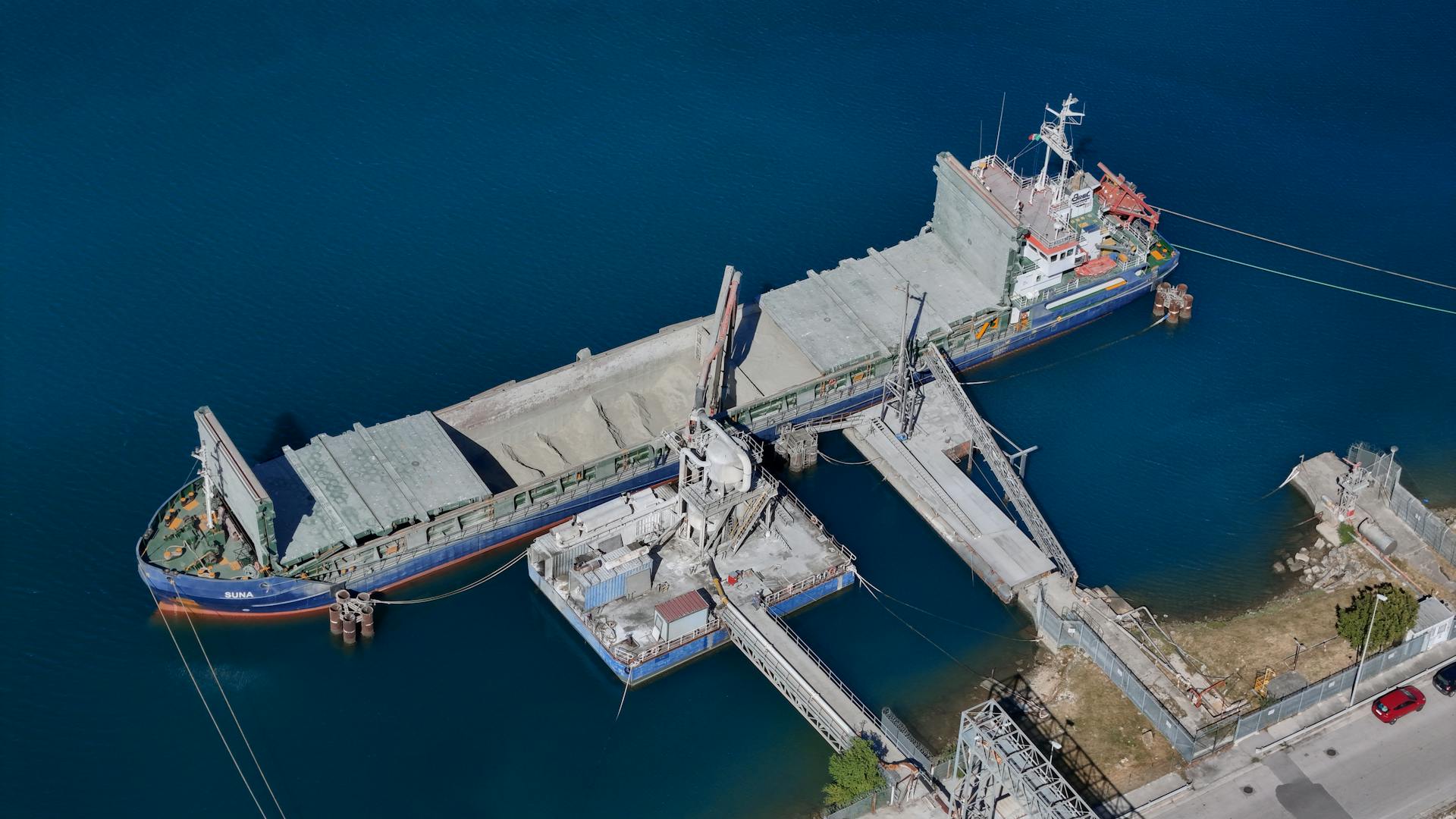
Steel Platforms, also known as Mobile Docks, are a type of loading dock platform that allows for safe forklift maneuvering into a truck and/or boxcar. They can be used in areas where space is limited.
Portable Loading Docks, a type of Steel Platform, can be placed in front of any dock or railcar door, serving three loading/unloading positions at the same time. This increases freight handling capabilities without the expense of site or concrete work.
Steel Platforms can be used one at a time or ganged for multiple dock positions, enlarging the shipping or receiving area quickly. They are a perfect solution for remote shipping docks, with heavy-duty lines starting at 16,000 lbs.
Here are some key features of Steel Platforms:
- All-Steel Welded Construction
- Diamond Tread Travel Surface
- Standard Capacities from 16,000 to 30,000 Lbs.
- Modular Designs
- 8” Runoff Curbs on Any 2 Sides
- Adjustable or Fixed Legs
Loading Dock Platform Types
Portable Steel Platforms are a popular choice for loading docks, offering capacities up to 30,000 pounds and lengths reaching 12 feet. They are heavier and require a forklift to move.

Steel Platforms, like the ones from Bluff, are a fast and economical way to expand your dock area and increase freight handling capabilities. They can be easily relocated to other areas of your yard where a free-standing loading dock may be needed.
These platforms come in various models, including the 16SP810-AL, which has a capacity of 16,000 pounds and measures 8 feet wide by 10 feet long. Other models, such as the 30SP812-AL, have a capacity of 30,000 pounds and measure 8 feet wide by 12 feet long.
Steel Platforms can be used as a satellite unloading area in remote areas, along with a Yard Ramp, to serve as a temporary loading dock. They are also a great solution for remote shipping docks where space is limited.
Some key features of Steel Platforms include all-steel welded construction, diamond tread travel surface, and standard capacities from 16,000 to 30,000 pounds. They also come with modular designs, 8” runoff curbs on any two sides, and adjustable or fixed legs.
Here are some common types of Steel Platforms:
These are just a few examples of the many types of Steel Platforms available. Be sure to choose the right one for your specific needs.
Choosing Between Board and Dock Plate
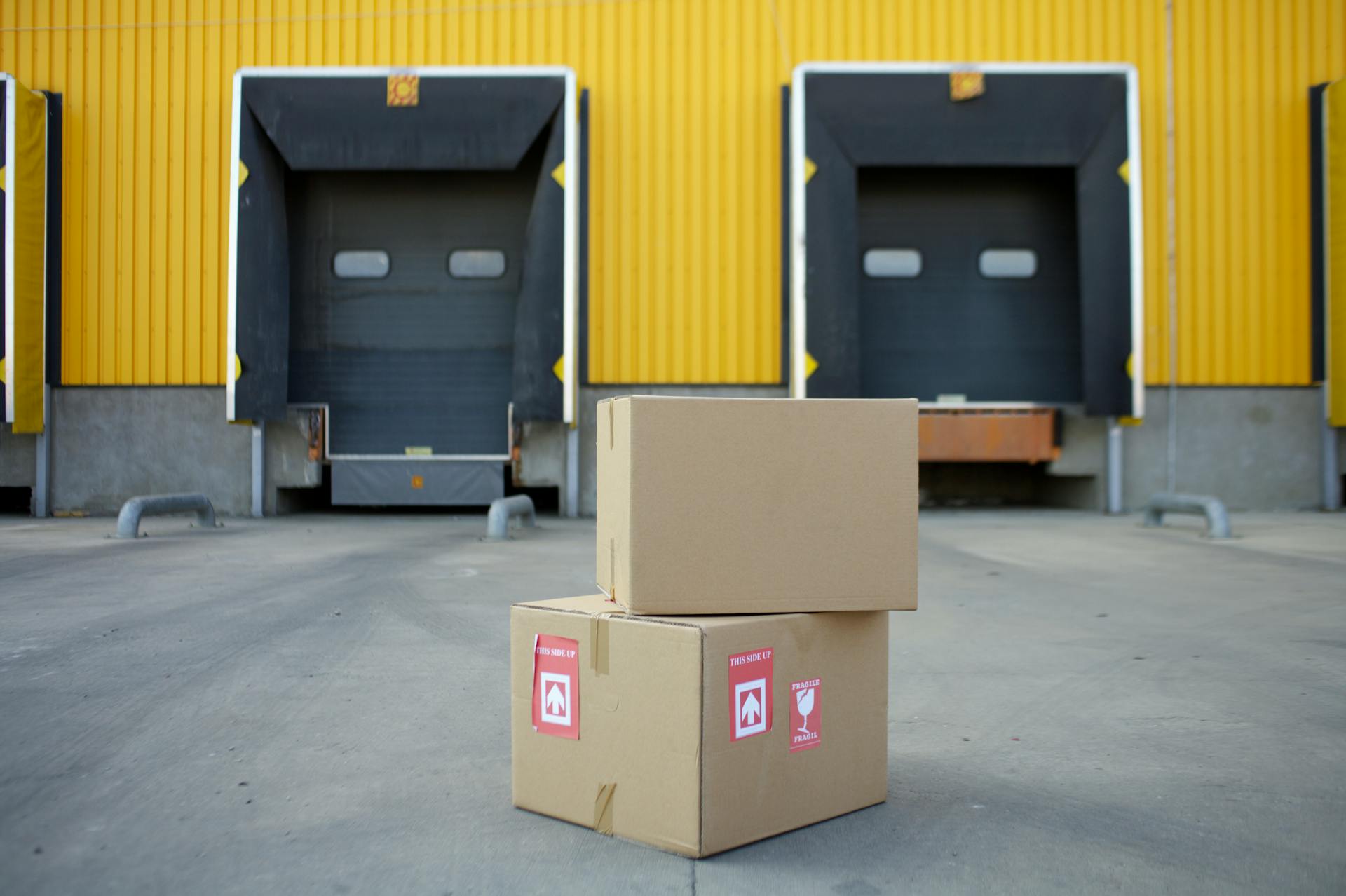
A dock board is a more versatile option, suitable for a wide range of applications, including heavy-duty use.
It's often made of durable materials like steel or aluminum, which can withstand heavy loads and frequent use.
In contrast, a dock plate is typically used for lighter loads and is often installed in a fixed position.
Dock plates usually require a pit or a recess to be installed in the floor, which can be a drawback for some users.
However, a dock plate can be a cost-effective option for smaller operations or those with limited space.
It's essential to consider the specific needs of your operation when deciding between a dock board and a dock plate.
Design and Stability
Our loading dock platforms are designed to be incredibly stable, thanks to their high-strength steel construction and wide-flange beams that evenly distribute weight. This enables them to support heavy loads without compromising safety.
These platforms are built to last, with a self-standing design that mimics the performance and integrity of a permanent concrete loading dock. They're perfect for high-speed cross-dock distribution, order fulfillment centers, and warehousing.
Here are some key features that contribute to their stability:
- Architecturally-engineered as self-standing steel structures.
- Dock positions are built to absorb trailer impact forces.
- Solid girders with a “z” shape creates a stronger connection between side beams.
Structural Stability
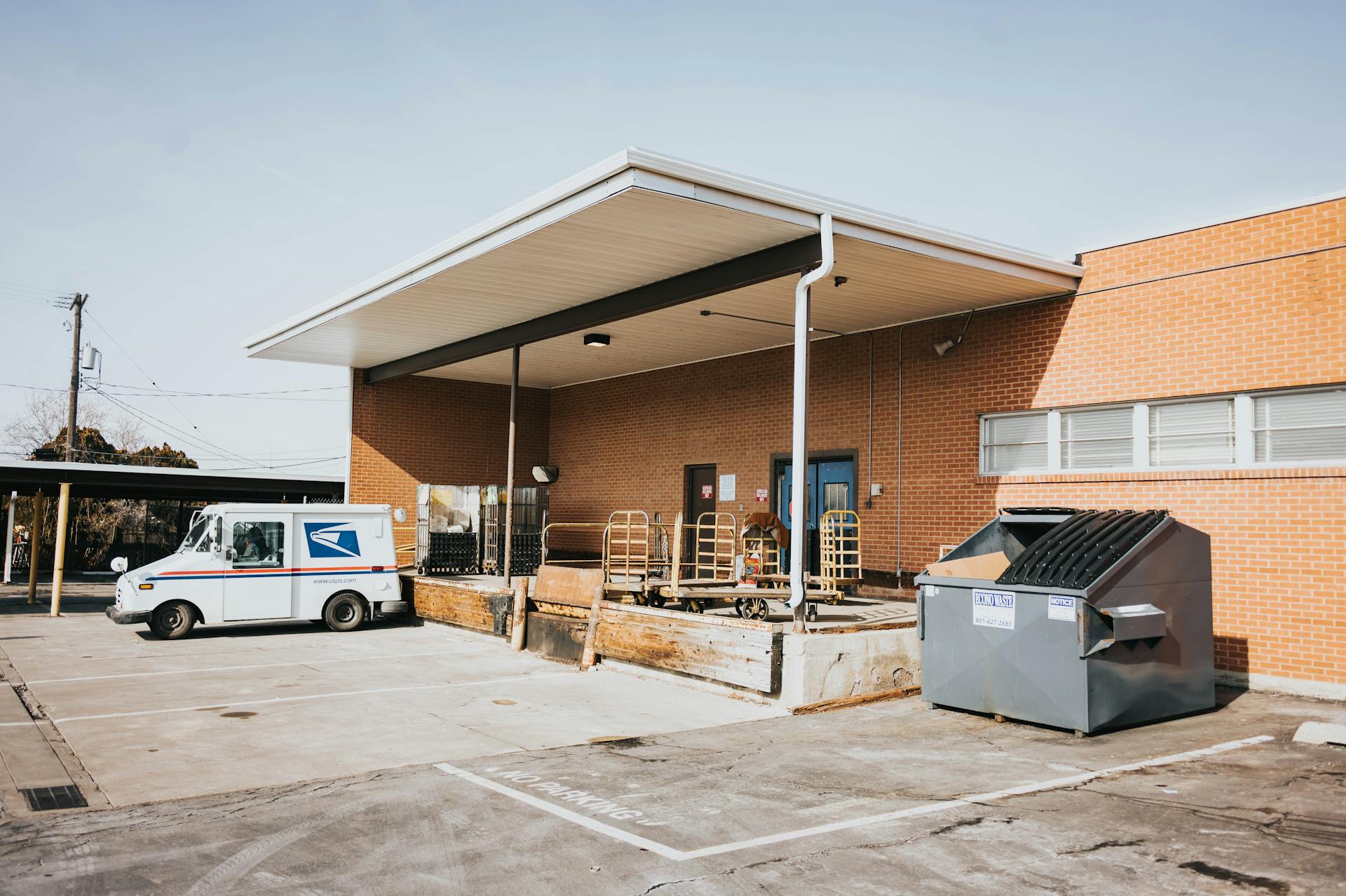
Our loading dock platforms are designed to be incredibly stable, thanks to their structural integrity. They're built with high-strength steel and wide-flange beams that evenly distribute weight, allowing them to support up to 85,000 lbs.
This level of stability is crucial for high-speed cross-dock distribution, order fulfillment centers, and warehousing, where heavy equipment and large shipments are the norm. The platforms can withstand the impact of trailers and heavy loads without compromising their structure.
The self-standing design of our platforms is also a key factor in their stability. Solid girders with a "z" shape create a stronger connection between side beams, providing added support and preventing any potential weaknesses in the structure.
Here are some key features of our self-standing design:
- Architecturally-engineered as self-standing steel structures.
- Dock positions are built to absorb trailer impact forces.
- Solid girders with a “z” shape creates a stronger connection between side beams.
This level of stability and support is unparalleled in the industry, and it's a major reason why our loading dock platforms are the go-to choice for businesses that need reliable and efficient loading and unloading solutions.
Durable Outdoor

Portable loading docks are a great option for locations with limited space or no permanent facilities. They're used in combination with dock-to-ground or portable loading dock yard ramps.
These platforms are custom made to fit your specifications with fixed heights ranging from 42″ to 57″ and are available in capacities up to 30,000 pounds.
Two or more portable loading docks can be locked together to form a larger outdoor loading dock, providing more flexibility and space.
Each portable loading platform comes standard with steel tread plate decking, steel legs, two movable curb sections, and lift sleeves for safe easy handling by fork trucks.
Steel grating bars don't need maintenance and are spaced to allow debris and water to fall through, rather than collect on the surface.
Here are some key features to consider when looking at durable outdoor loading docks:
- Steel side plates made from A572-50 steel for added durability
- Edge-of-dock levelers can be installed on any side of the platform
- Platforms allow lift trucks to easily make right angle turns
Features and Options
A loading dock platform is a crucial investment for any business that relies on frequent shipments and deliveries. This type of platform can be customized to fit your specific needs.

The platform's height can be adjusted to accommodate different types of vehicles, including trucks, vans, and even forklifts. Some loading dock platforms can be raised or lowered to a height of 24 inches, while others can reach up to 48 inches.
A hydraulic system is often used to power the platform's movement, providing a smooth and quiet operation. This system can be controlled manually or automatically, depending on the specific design of the platform.
Custom Options
Custom platforms can be designed to meet specific needs with an in-house engineering team.
Handrails can be added to any platform at any length required, and our 42-inch high split handrails are constructed in all steel.
Custom platforms can be tailored to fit unique problems or specifications.
Handrails can be added to any platform, giving you flexibility in how you design your space.
Our 42-inch high split handrails are a sturdy option, constructed in all steel for durability.
Specify Correct Leveler

For a hydraulic elevating dock, you'll want to consider the maximum gross vehicle weight (GVW) it's rated for, which is typically 10 tons for a standard dock.
Elevating docks come in various sizes, but a common installed size is a 6 ft wide, 8 ft long table with a capacity of 4500 lb.
If you're using a rider forklift, you'll likely need a larger dock, such as a 6 ft wide, 10 ft long table with a capacity of 5 tons.
The scissor-lift design is typical for elevating docks, allowing for a 6 ft vertical travel, which is a common standard.
Worth a look: Weston Point Docks
Edge Levelers
Edge levelers are a great option for warehouses and shipping facilities. They're a low-cost alternative to traditional dock levelers.
The Edge-of-Dock (EOD) leveler is a type of edge leveler that's commonly used. It's available in standard load capacities of up to 35,000 lb.
EODs are mounted to the face of the dock and secured to a curb channel embedded in the concrete. They're suitable for applications where there's little variation in bed height.
On a similar theme: Exterior Loading Dock Leveler
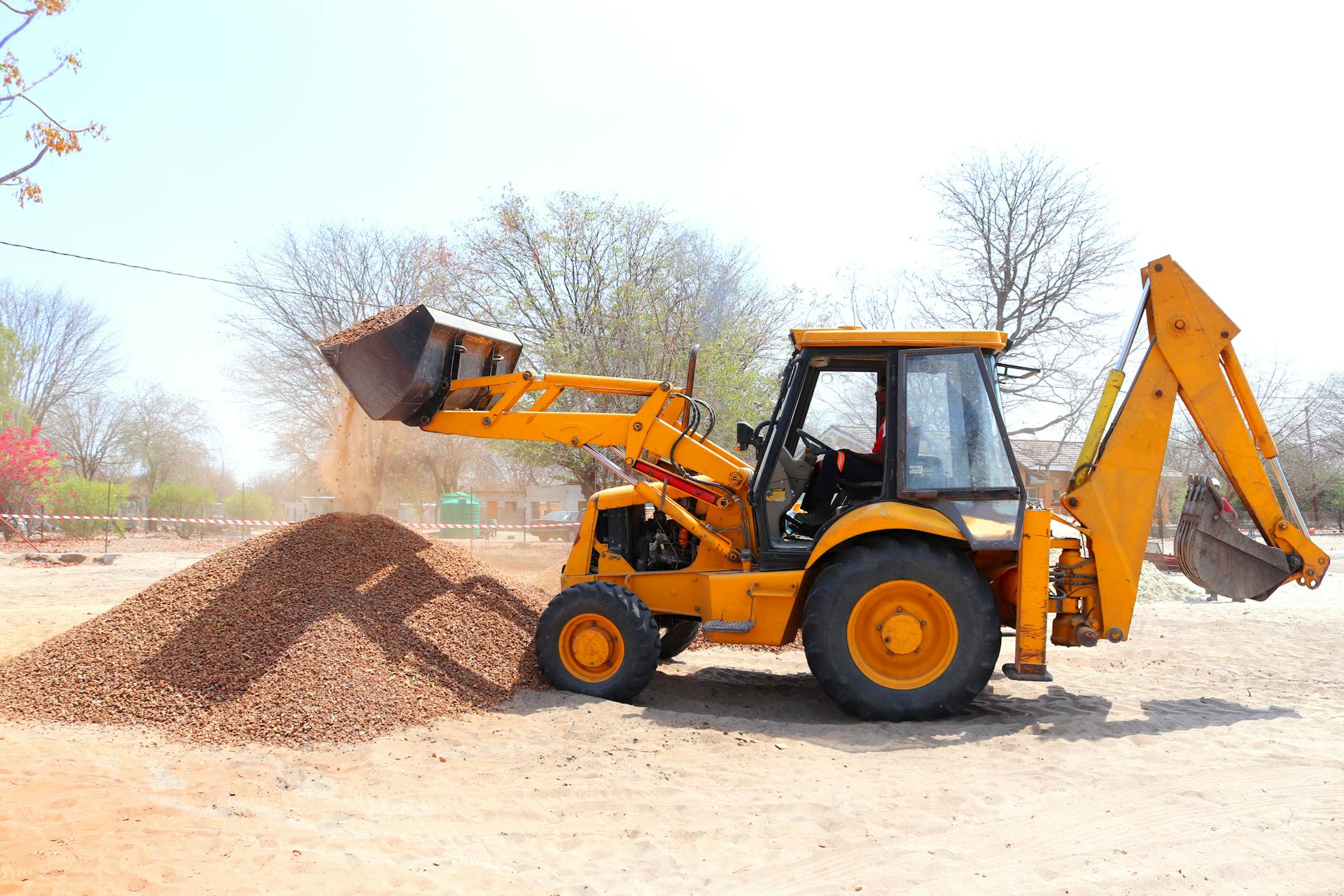
The EOD has a short ramp, which restricts its service range to 2 in. above or below the dock. This means it's not ideal for applications with varying bed heights.
Using an EOD with a manual hand pallet cart can be tricky if there's a 2 in. difference in height between the dock and trailer. Make sure the dock and trailer are at the same height to avoid any issues.
EODs come in two widths: 72 in. and 66 in. The 72 in. wide EODs offer more flexibility, but the 66 in. wide EOD is the most popular choice.
There are two types of EOD activation systems: mechanical and hydraulic.
Here's an interesting read: Wide Load vs Oversize Load
Installation and Use
To install a loading dock platform, you'll first need to set up the yard ramp using the attached hydraulic pump, which allows you to raise the ramp at a ½” increment for each pump movement.
This makes it easy to position the ramp in the desired location.
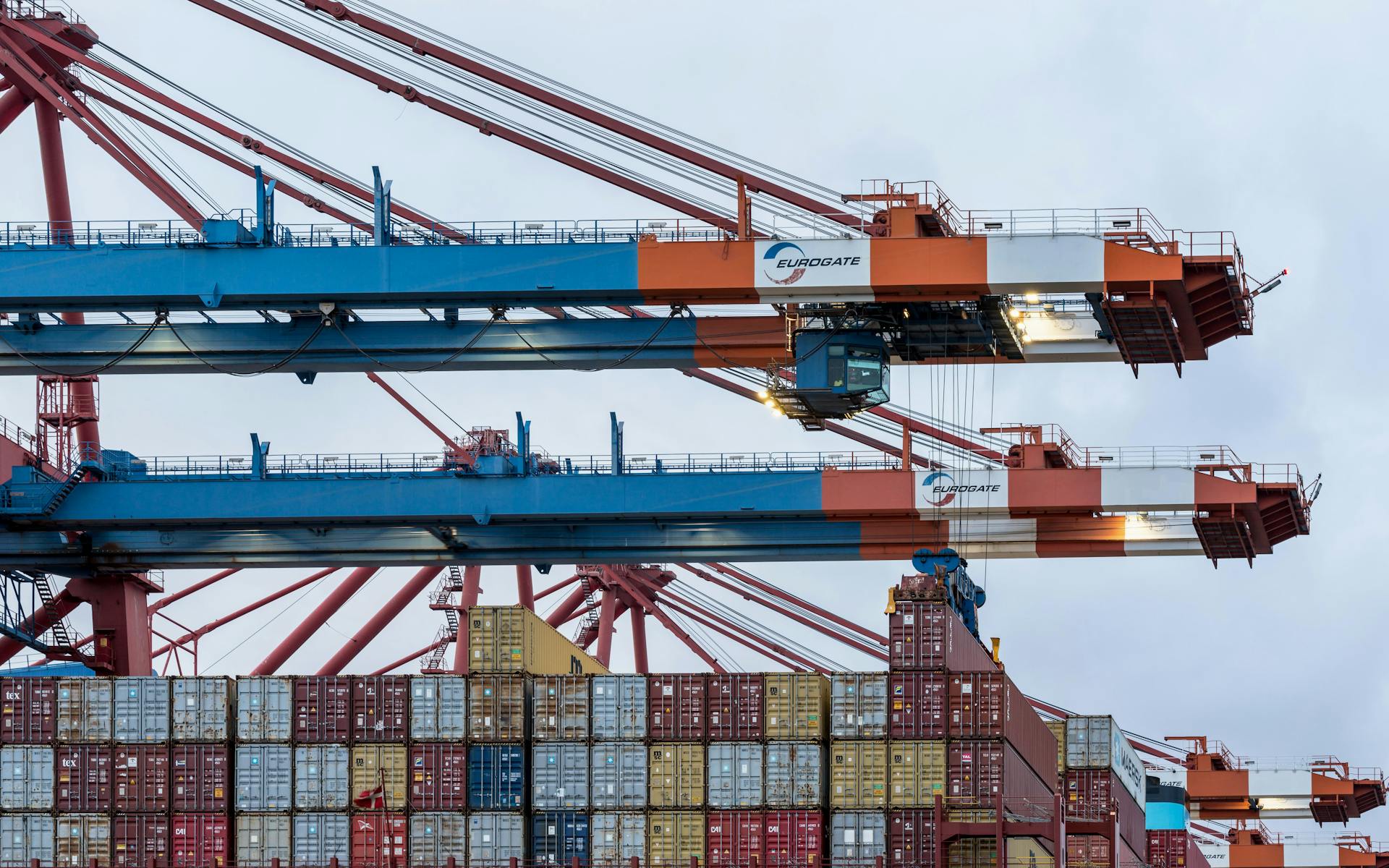
A forklift can then be connected to the yard ramp's positioning sleeve using chains, allowing you to maneuver the ramp to the correct angle.
Once you've reached the desired position, release the hydraulic pump valve, and the 15-inch lip will sit against the carrier body.
Finally, connect the attached safety chains to your yard ramp and you're ready to start loading.
Components and Accessories
A loading dock platform is only as good as its components and accessories. A hydraulic lift is a common component used in loading dock platforms, allowing for easy and safe loading and unloading of goods.
The type of floor used can greatly impact the durability and functionality of the platform. A steel floor is often used due to its strength and resistance to heavy loads.
Some platforms also come equipped with a dock leveler, which helps to create a smooth and even surface for loading and unloading. This can be especially useful for platforms that will be used for frequent deliveries.
Platform Deck Grating
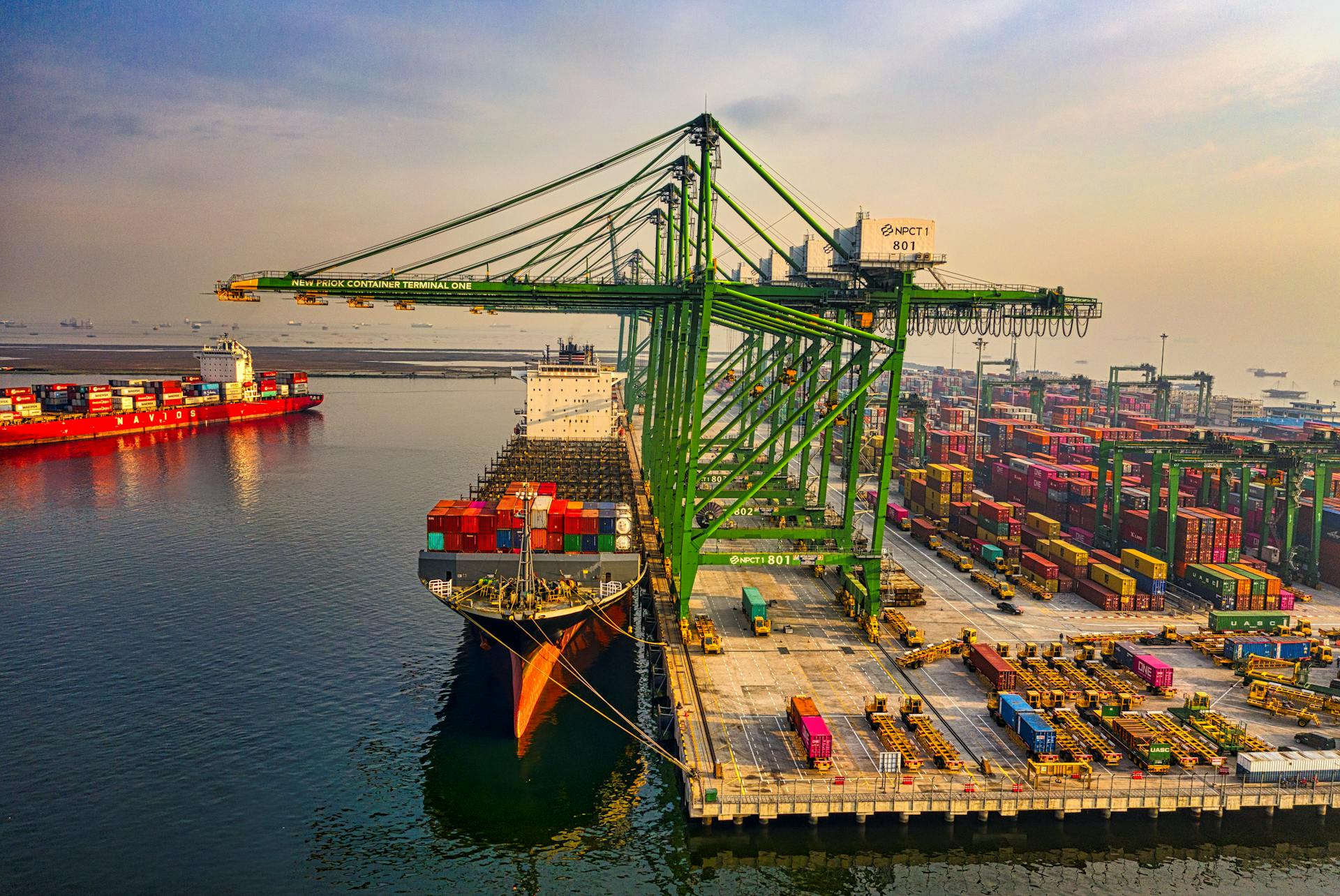
Platform Deck Grating is constructed of electro-forged serrated steel for superior strength. This material provides extra durability in rough applications.
Grating bearing bars are 1-3/4″ thick, designed to resist clogging of debris and ensure a high-traction running surface. Bars are spaced 1″ apart for maximum traction.
Lift loops are provided for easy handling and repositioning of the platforms with a forklift. This feature makes it simple to move the platforms around as needed.
Recessed Levelers
Recessed Levelers are a type of adjustable foot used to level and stabilize furniture on uneven surfaces.
They can be adjusted to accommodate different floor heights and are often used under heavy furniture like bookshelves and cabinets.
Recessed Levelers can be made of plastic or metal and come in different sizes to fit various furniture legs.
Their compact design allows them to be easily hidden from view, making them a popular choice for furniture makers and restorers.
Furniture makers often use Recessed Levelers to create stable and level bases for custom furniture pieces, ensuring they won't tip over on uneven floors.
Building Expansion

Building expansion can be a lengthy process, but it doesn't have to be. Dockzilla self-standing loading dock platforms make it possible to expand loading and shipping capabilities at any facility without any construction delays or permanent change to the building.
These platforms are designed to be flexible and adaptable, allowing you to increase your facility's capacity without disrupting your operations.
With Dockzilla, you can easily add more loading and shipping areas as needed, without having to worry about costly renovations or downtime.
Curbs
Curbs are a crucial component to consider when it comes to loading dock safety. 6″ portable loading dock safety curbs can prevent accidental runoff.
These curbs are designed to withstand heavy loads and the extra strain of cargo breakout. The exclusive hollow section design and proprietary box frame construction make them particularly effective.
Portable curbs can be easily installed and removed as needed, making them a convenient option. They're perfect for temporary or seasonal use.
For another approach, see: Loading Dock Safety Equipment
Customization and Selection
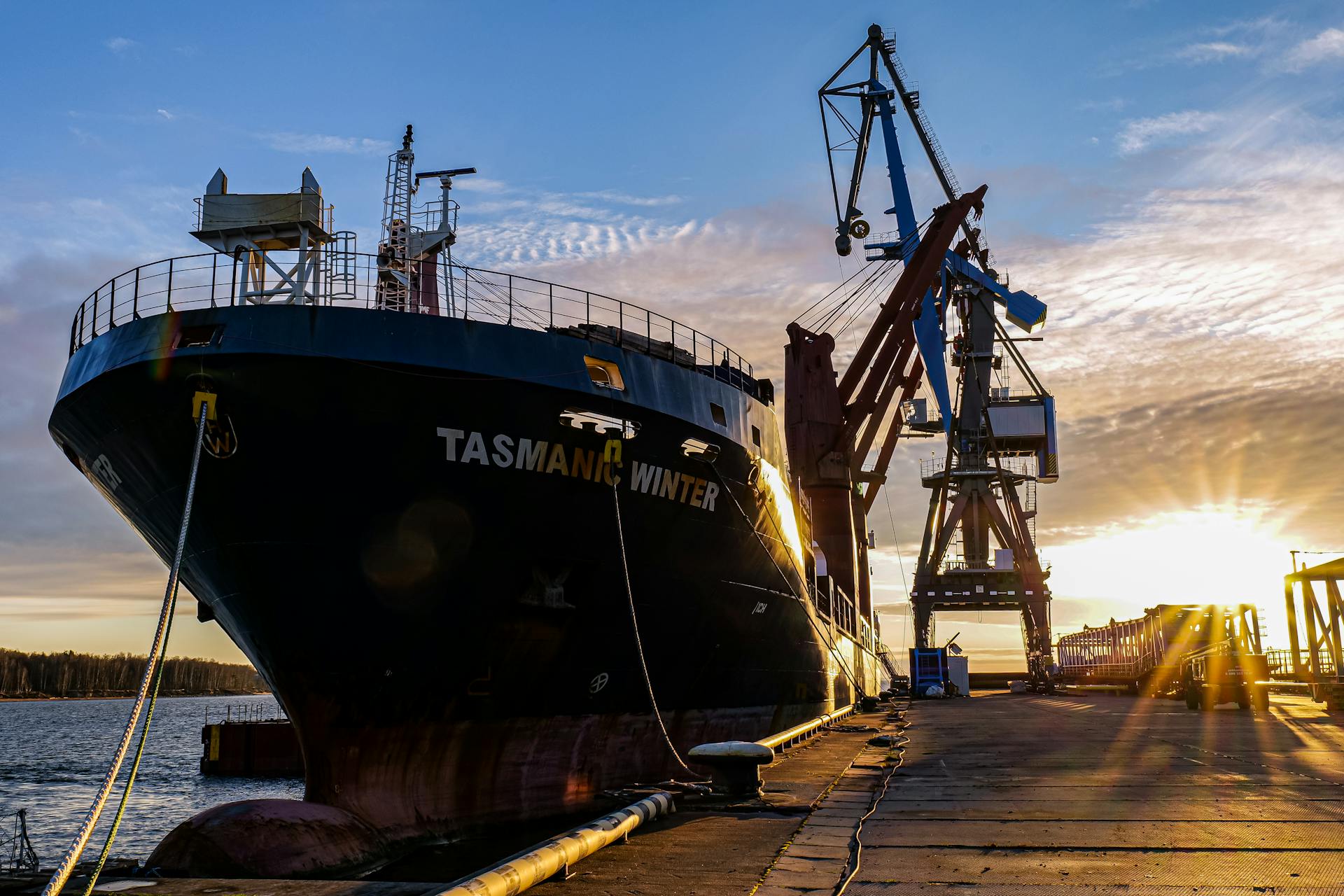
When you need a loading dock platform that meets your specific needs, customization is key. YARD RAMP Site offers tailor-made temporary platforms for any unique problem or specification.
With an in-house engineering team, you can expect a high level of expertise and attention to detail. This ensures that your custom platform is designed and built to exacting standards.
The ability to select from custom options gives you the flexibility to choose a platform that fits your specific requirements. Whether it's a standard or non-standard size, a custom platform can be designed to meet your needs.
By choosing a custom platform, you can avoid the limitations of off-the-shelf solutions. This is especially important if you have a complex or unusual loading dock setup.
Outdoor Features
Portable loading docks offer a range of features to ensure safe and efficient loading operations.
A key feature is the 6″ portable loading dock safety curbs, which prevent accidental runoff and provide a secure edge for workers and vehicles.
Broaden your view: Portable Loading Docks
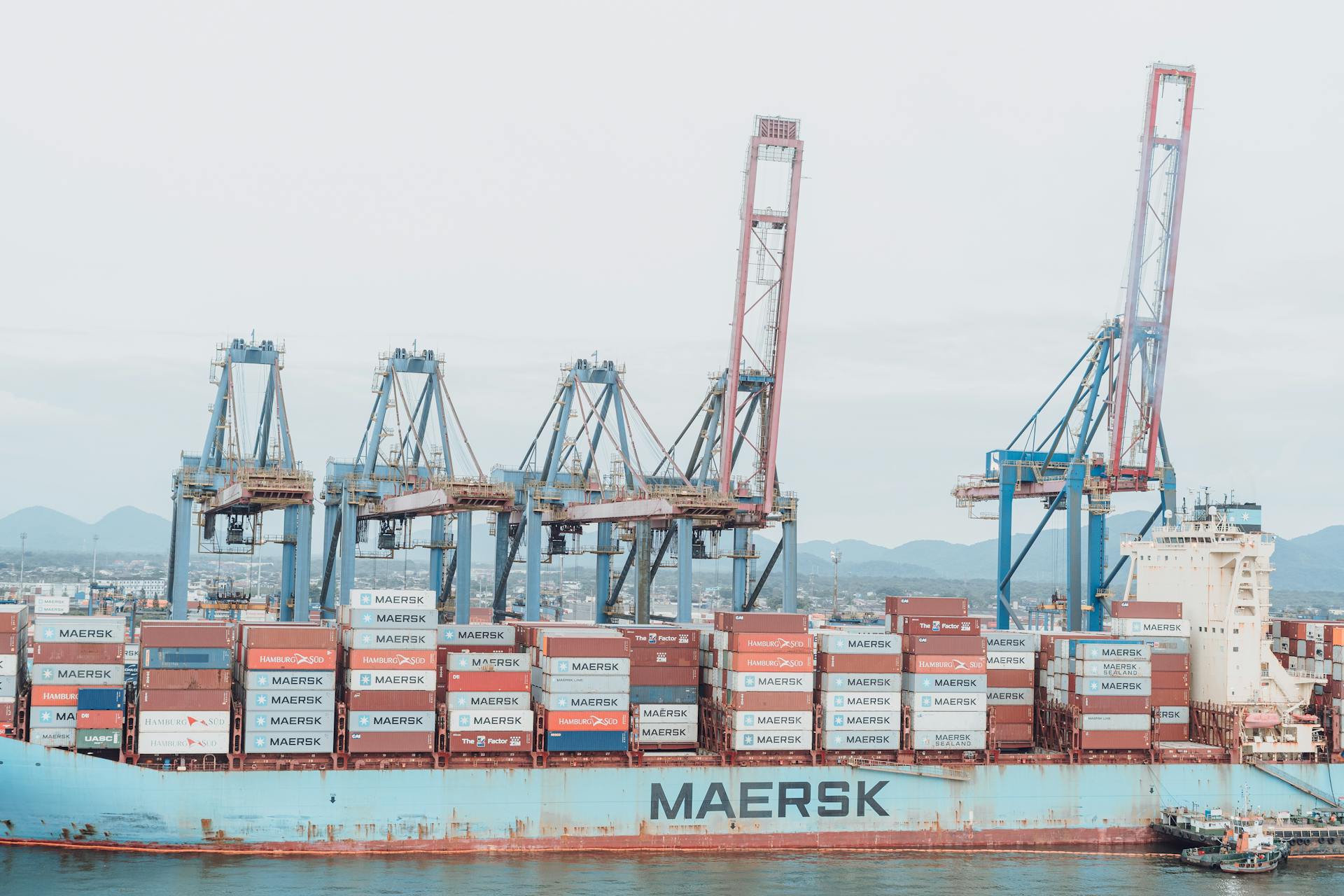
These safety curbs are designed to take the stress of heavy loads and the extra strain of cargo breakout, thanks to an exclusive hollow section design and proprietary box frame construction.
Steel grating bars don't require maintenance and are spaced to allow debris and water to fall through, rather than collect on the surface.
The steel used in these platforms is A572-50 steel, providing additional durability and strength.
Here are some key features of portable loading docks:
- Steel tread plate decking for a durable and slip-resistant surface
- Steel legs for stability and support
- Movable curb sections for easy handling by fork trucks
- Lift sleeves for safe and easy handling
- Edge-of-dock levelers for functionality with any existing equipment, vehicles, or installations
Sources
- https://bluffmanufacturing.com/yard-ramps/steel-platforms-mobile-dock-platforms/
- https://dockzilla.com/dockzilla-durable-platforms/
- https://copperloy.com/yard-ramps/aluminum-yard-ramps/outdoor-loading-dock/
- https://the-ramp-site.com/yard-ramps/portable-loading-docks/
- https://novalocks.com/dock-levelers/
Featured Images: pexels.com
